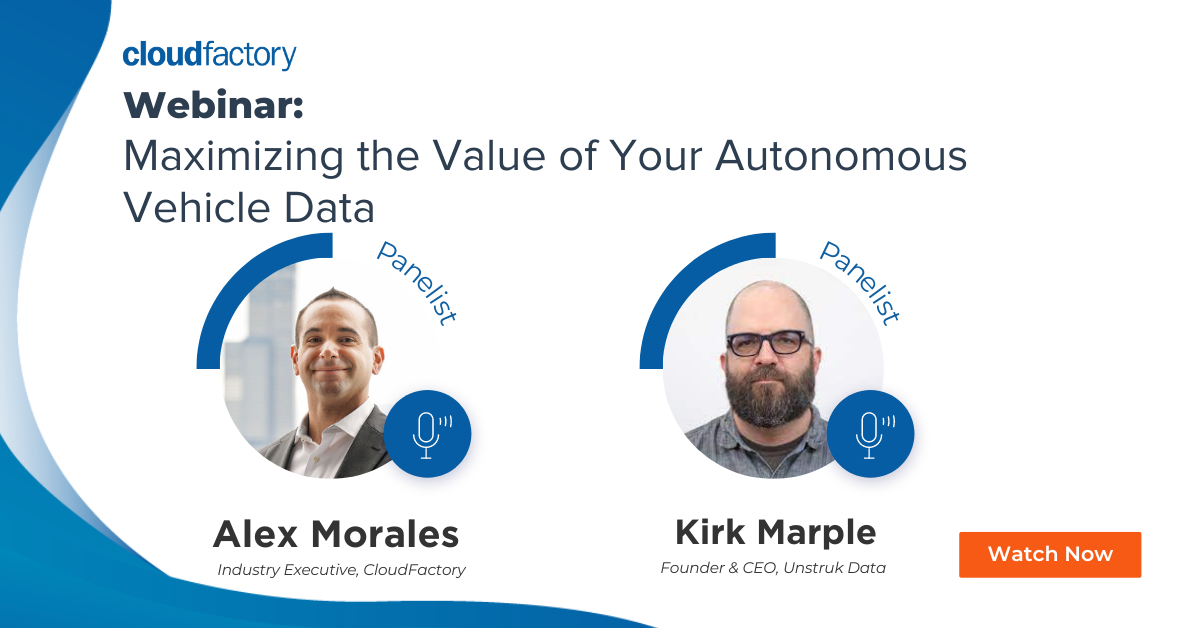There’s no question that autonomous vehicle developers are under a lot of pressure to deliver highly capable AI models quickly and cost-effectively. While sensor technologies and adaptive algorithms have improved to better handle edge cases, these advances are overshadowed by negative press and canceled projects due to a tightening economy.
In the webinar Maximizing the Value of Your Autonomous Vehicle Data, Alex Morales, Industry Executive at CloudFactory, and Kirk Marple, CEO of Unstruk Data, discuss these challenges and share how you can overcome them by improving your data quality.
If you don't have time to watch the entire webinar today, this blog post summarizes the top 4 takeaways from their conversation:
- Why AV developers need to demonstrate effective operations quickly — ideally, first to market — with a safe operating model.
- How improving the quality of the data you already have with human-in-the-loop labeling reduces time to market.
- Why quality is important, but data must also be useful to deliver AV models that safely navigate edge cases.
- How leveraging technology and tools speeds data enrichment, enabling you to get the most value from your data.
4 ways to maximize the value of your AV data
Ready to take hold of your AV data strategy and overcome impediments? Here are the top four takeaways shared in the webinar.
1. AV model safety and time to market are now equally important
A year ago, the number one priority for AV development projects was safely handling a seemingly endless list of edge cases. But recent negative press about self-driving vehicles struggling with edge cases that seem “routine” for humans and a tightening economy caused companies to re-evaluate the near-term profitability of even the most promising projects.
Companies with successful early trials and demonstrations, especially in the case of autonomous taxis, continue to thrive. Other projects have been disbanded or merged in an effort to reduce costs and speed time to market. When AI projects stall or fail, it’s almost always because of poor training data quality leading to unreliable models. This increases costs and time to market. With the right process and partners, you can build safe AV applications from the typical large datasets required for edge cases and keep your project on schedule.
2. Improve your data quality with human-in-the-loop annotation
Imagine if there was a way to overcome these challenges with AI project time aggregating, cleaning, labeling, and augmenting data while reducing data errors. This not only gives you the quality data you need for a safe and effective AV model but also reduces your time to market.
Collecting mass volumes of data needed for a wide variety of driving environments is expensive. All of that data can be a drain on your IT resources and your AV developers’ time. Human-in-the-loop annotators can help you control these costs. When your training data is accurately labeled and segmented, it’s easy to organize and prioritize what to keep and use for the model. Once you know what data you have, you can make sure that it fits with the goals you defined for model safety.
3. Quality is important, but data must also be useful
Another benefit of human annotation to enrich AV model data is establishing the context for using it. It can be extremely valuable to know if old data is useful for validating updates to retrain the current models or to train new models. It’s also important to be able to find accurate data as needed to cover all scenarios.
You want your data to be accessible when you need it, but you also want to be cost-conscious about storage. Cold storage and archival storage is often much less expensive than storing data you need regular and immediate access to. Cataloging data helps to make it easier to find and access less frequently used data while controlling costs.
4. Technology and tools speed data enrichment
Using technology to increase the value of your AV model data is a great complement to human-in-the-loop annotations. Many AV developers have developed in-house tools that are optimized for their model development workflow. Or you may choose a third-party tool that’s proven to be both accurate and efficient for your specific type of data. AI-assisted data labeling tools coupled with human annotators provide a great balance of speed and accuracy.
But the speed and level of quality required for data annotations depends on where you are in your AV model development. In the early stages, it may be more efficient to manually annotate training data in-house for quicker turnaround of smaller data sets. As data volumes grow and use cases become more complex, a scalable workforce coupled with tools that help to speed data enrichment but also facilitate the flow of data from source repositories to developers training the AV model.
Quality data is critical to AV projects
These are just highlights of the engaging conversation between Alex and Kirk managing and enriching AV training data for maximum value. Be sure to watch the full webinar replay to get the details with examples from their experiences and uncover how CloudFactory can help you achieve your AV data quality goals.
Computer Vision AI & Machine Learning Data Annotation Image Segmentation



